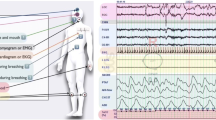Abstract
Purpose
Four-hour voiding observation is a conventional method for evaluating bladder function in infants. However, it requires a diaper check every 5 min during the observation period, which creates an unusual environment for the infant, making the evaluation of natural urination difficult. This study aimed to investigate the parameters of urination before mature bladder function using a diaper equipped with a urination-activated alarm system.
Methods
The study participants were 51 infants aged 0–4 years without bladder dysfunction. A urination-activated sensor was used to notify the inspector wirelessly when urination was detected, enabling the immediate assessment of ultrasonically measured residual urine. Bladder capacity was calculated as the sum of both residual urine volume and micturition volume, and the residual urine rate as the residual urine volume divided by bladder capacity.
Results
A total of 36 boys and 15 girls were enrolled. The median (interquartile range) residual urine volume, bladder capacity, and residual urine rate were 3.0 mL (1.1–6.6), 53.0 mL (33.9–75.3), and 7.0% (2.1–15.0), respectively. Infants aged 0–1 and 2–4 years were then classified into Group A (N = 27) and Group B (N = 24), respectively. The residual urine rate was significantly higher in Group A (11.0% [5.4–21.2]) than in Group B (4.8% [0.6–8.9]; p < 0.01).
Conclusions
Voiding observation using a urination-activated alarm system allowed less invasive analysis in infants and revealed that the residual urine rate decreased with mature bladder function from about 2 years of age.



Similar content being viewed by others
Abbreviations
- PVR:
-
Post-void residual urine
- VV:
-
Voided volume
- BC:
-
Bladder capacity
- %RU:
-
Residual urine rate
- IQR:
-
Interquartile range
References
Koff SA. Evaluation and management of voiding disorders in children. Urol Clin North Am. 1988;15:769–75.
Holmdahl G, Hanson E, Hanson M, et al. Four-hour voiding observation in healthy infants. J Urol. 1996;156:1809–12.
Chang SJ, Chiang IN, Hsieh CH, et al. Age- and gender-specific nomograms for single and dual post-void residual urine in healthy children. Neurourol Urodyn. 2013;32:1014–84.
Austin PF, Bauer SB, Bower W, et al. The standardization of terminology of lower urinary tract function in children and adolescents: update report from the standardization committee of the International Children’s Continence Society. Neurourol Urodyn. 2016;35:471–81.
Wide P, Duchén K, Mattsson S, et al. Four-hour voiding observation with provocation test reveals significant abnormalities of bladder function in newborns with spinal dysraphism. J Pediatr Urol. 2020;16:491.e1-e7.
Holmdahl G, Hanson E, Hanson M, et al. Four-hour voiding observation in young boys with posterior urethral valves. J Urol. 1998;160:1477–81.
Gladh G, Persson D, Mattsson S, et al. Voiding pattern in healthy newborns. Neurourol Urodyn. 2000;19:177–84.
Jansson UB, Hanson M, Hanson E, et al. Voiding pattern in healthy children 0 to 3 years old: a longitudinal study. J Urol. 2000;164:2050–4.
Sillén U, Sölsnes E, Hellström AL, et al. The voiding pattern of healthy preterm neonates. J Urol. 2000;163:278–81.
Borg H, Sillén U, Doroszkiewicz M, et al. Four-hour voiding observations detect neurogenic lower urinary tract dysfunction in neonates with anorectal malformation. J Pediatr Urol. 2020;17(76):e1-9.
Hiraoka M, Hori C, Tsukahara H, et al. Voiding function study with ultrasound in male and female neonates. Kidney Int. 1999;55:1920–6.
Fairhurst JJ, Rubin CM, Hyde I, et al. Bladder capacity in infants. J Pediatr Surg. 1991;26:55–7.
Hjälmås K. Urodynamics in normal infants and children. Scand J Urol Nephrol Suppl. 1988;114:20–7.
Costa DF, Lavallée LT, Dubois C, et al. Are we accurately predicting bladder capacity in infants? Can Urol Assoc J. 2014;8:329–32.
Allen TD, Bright TC 3rd. Urodynamic patterns in children with dysfunctional voiding problems. J Urol. 1978;119:247–9.
Guerra L, Leonard M, Castagnetti M. Best practice in the assessment of bladder function in infants. Ther Adv Urol. 2014;6:148–64.
Geraniotis E, Koff SA, Enrile B. The prophylactic use of clean intermittent catheterization in the treatment of infants and young children with myelomeningocele and neurogenic bladder dysfunction. J Urol. 1988;139:85–6.
Holmdahl G, Sillén U, Bachelard M, et al. The changing urodynamic pattern in valve bladders during infancy. J Urol. 1995;153:463–7.
Joseph DB, Bauer SB, Colodny AH, et al. Clean, intermittent catheterization of infants with neurogenic bladder. Pediatrics. 1989;84:78–82.
Sillén U, Bachelard M, Hermanson G, et al. Gross bilateral reflux in infants: gradual decrease of initial detrusor hypercontractility. J Urol. 1996;155:668–72.
Acknowledgements
The authors wish to acknowledge Dr. Tajiri, Professor of Pediatric Surgery, Kyoto Prefectural University of Medicine, for his help in acquiring the target population in the present study.
Author information
Authors and Affiliations
Corresponding author
Ethics declarations
Conflict of interest
All authors declare that they have no conflicts of interest. This research did not receive any specific grant from funding agencies in the public, commercial, or not-for-profit sectors. No funding was received for this study.
Ethical approval
The protocol for this research project was approved by the Ethics Committee of the Kyoto Prefectural University of Medicine and conforms to the provisions of the Declaration of Helsinki (Clinical trial No.: ERB-C-1290).
Informed consent
Informed consent was obtained from all subject(s) and/or guardian(s).
Additional information
Publisher's Note
Springer Nature remains neutral with regard to jurisdictional claims in published maps and institutional affiliations.
Appendix
Appendix
The therapeutic instrument for nocturnal enuresis (Pisscall®) was supplied by Awajitec Business Corporation; however, neither the results of the study nor the statistical analyses were influenced by this company.
About this article
Cite this article
Ajiki, J., Naitoh, Y., Inoue, Y. et al. Effectiveness of a voiding evaluation technique using a diaper equipped with a urination-activated alarm system to assess bladder function and voiding patterns in infants. J Med Ultrasonics 49, 695–701 (2022). https://doi.org/10.1007/s10396-022-01251-1
Received:
Accepted:
Published:
Issue Date:
DOI: https://doi.org/10.1007/s10396-022-01251-1




